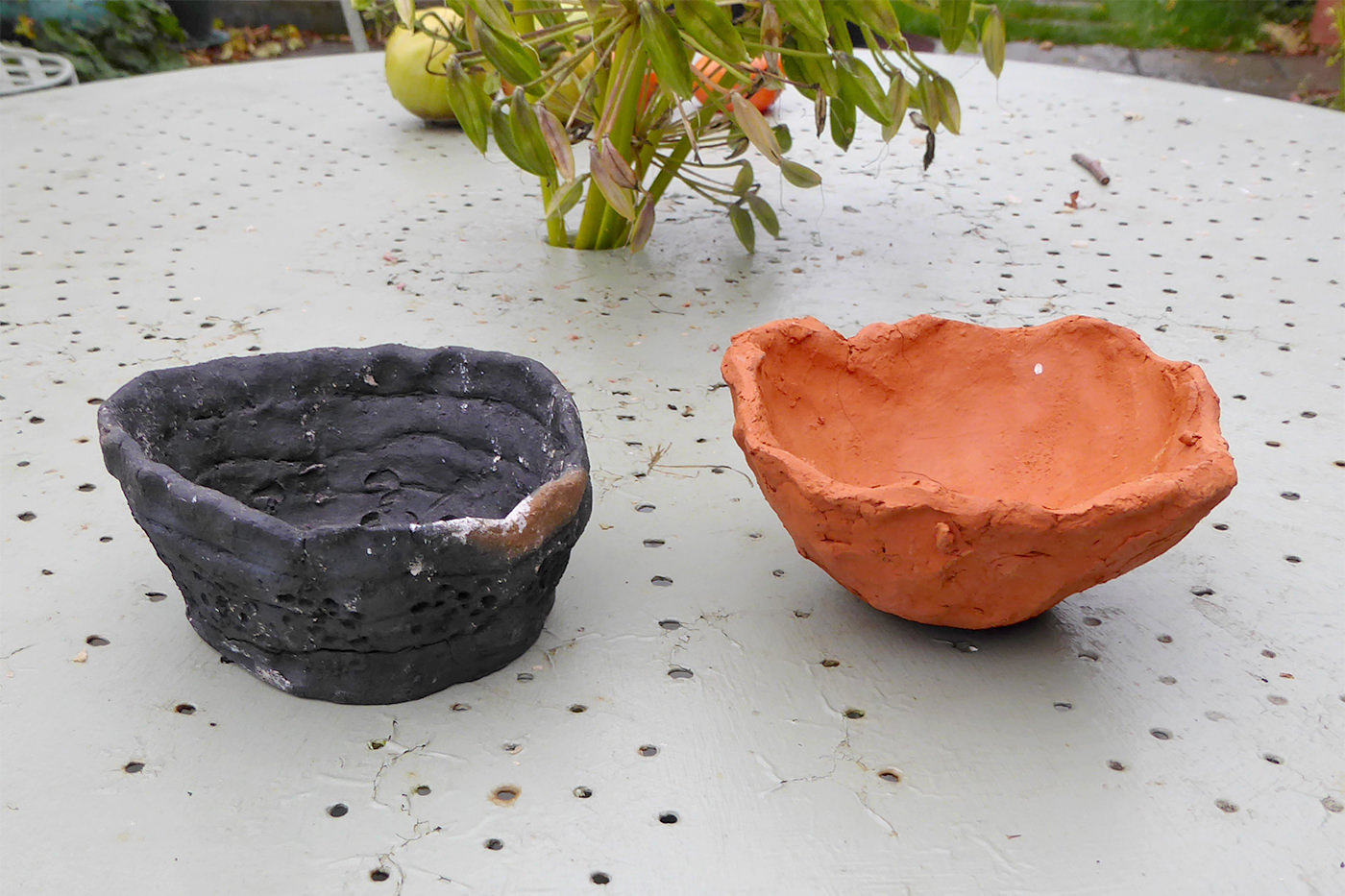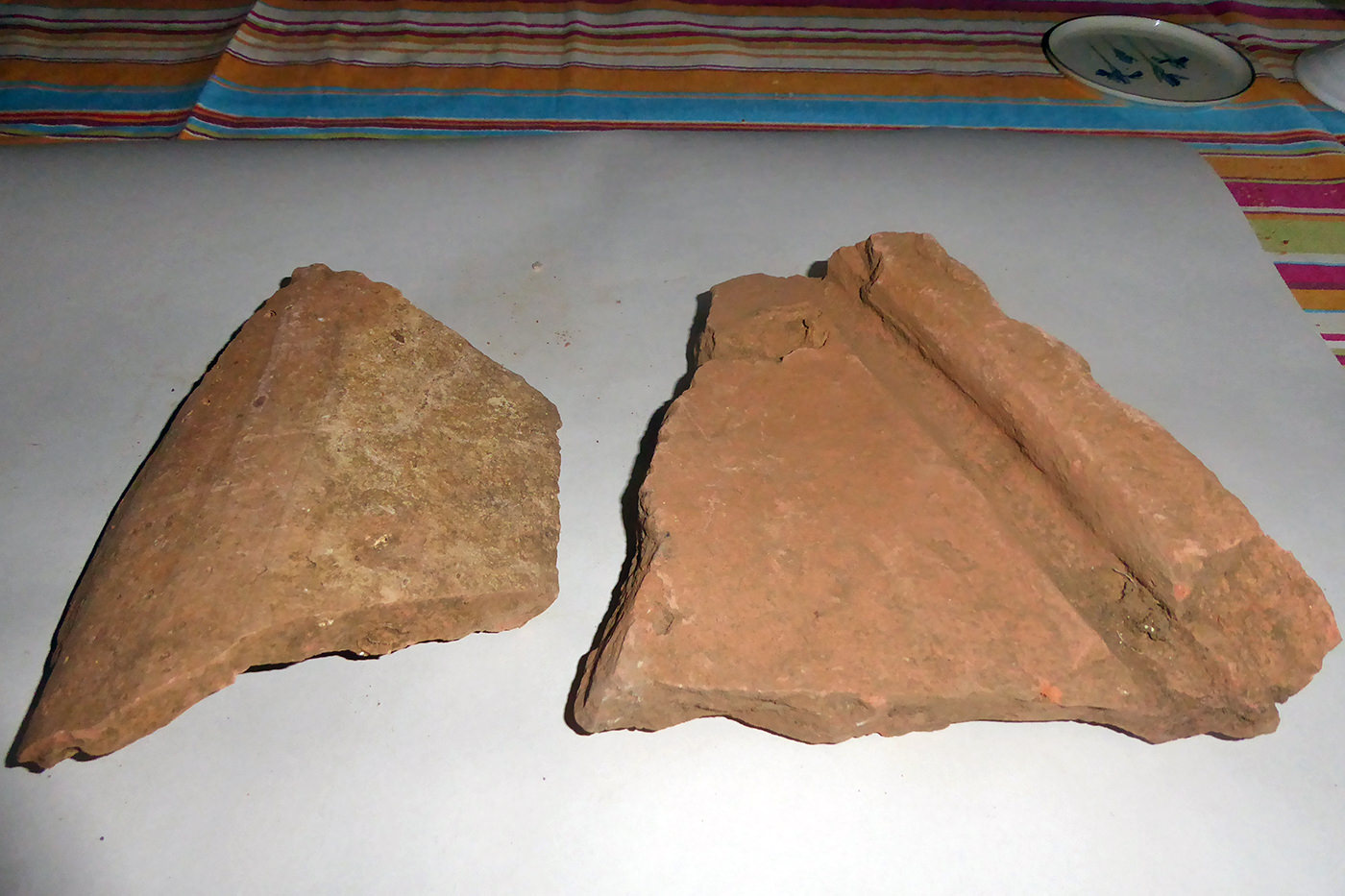Tackley History Mysteries No. 8
Were There Clay Pits on Tackley Heath?
There is a series of shallow depressions in the eastern part of the heath.
One or two are circular, the rest are irregular in shape, and all are about
1 to 1.5 metres deep. Were they once clay pits?
There are several pieces of evidence that point in this direction. First,
they do not appear natural — especially the circular ones. The fact that
there is no bank around them suggests that the material dug from them has
either been spread thinly round about or been taken away. If it had been
spread thinly, that still leaves the question of why were they dug.
Second, the heath sits on an outcrop of Oxford clay – oval in shape and
about 0.5 km wide by 1.8 km long – that lies on the high ground to
the east of the Banbury Road and runs from around the trig point across the
heath and through Tackley Wood (see this
British
Geological Survey map). The clay is just below the topsoil. There are
also several ponds on the clay: just east of Old Man Leys Farm; in the
north-eastern corner of the heath; and in Tackley Wood. Others that have
silted up or been filled in can be seen on the original 25-inch and 6-inch
Ordnance Survey maps which date from the late 19th and early 20th centuries
(these are available – digitised, searchable and free – on the
National Library
of Scotland website. The ponds lie on high ground, and it is difficult
to see how they could have been formed naturally. So they too could have
originally been clay pits.
Third, the trig point is in the field called Tacknalls; and about
200 metres down from the trig point towards the village is the site of
a brick kiln which is marked on the Gardiner estate map of 1787. No trace of
the kiln remains above ground. The site of the kiln is close to two further
depressions which are right on the edge of the clay outcrop and which must
have been the source of the clay for making bricks.
Putting these together, there is a plausible case for the depressions on
the heath being clay pits. If so, what was the clay used for? The brick kiln
in Tacknalls was probably in use not long before it was marked on the map,
say around 1770. It was most likely associated with building works on the
estate by the last John Morton who died in 1780 and who was responsible for
enlarging and remodelling Hill Court.
Or the bricks may have been used in working buildings on the estate. It was
not uncommon in the late 17th and 18th centuries for ‘improving’ landowners
to set up brickworks on their estates. Is there any surviving physical
evidence for the use of bricks in the village in the 18th century? Most
of Hill Court was demolished in 1959, so we don’t know if brick was used in
its remodelling. If there were clay pits on the heath, they may also have
been used for brickmaking in the 18th century, but any evidence on the
ground is invisible under the bracken.
Stone has been the main building material here for centuries; and before
that wood, turf, wattle and daub. But much earlier we had a
Roman villa at Street Farm –
built of stone and wood, not brick – roofed partly with classic Roman
ceramic tiles. Were they made here with our local clay, or were they brought
in? Was there small-scale production of Roman tiles here? The Street Farm
villa alone might not have generated enough demand.
But there is the possibility of another
substantial Roman building, even a villa, in Nethercott; and broken
pieces of Roman tile occasionally turn up among the pottery scatters around
the village, suggesting that the Roman farmsteads here may also have been
partially tiled. Chemical analysis of tiles from the villa might settle the
question.
Tackley Clay and Pottery
 Experimental pots made with Tackley clay
Experimental pots made with Tackley clay
Tackley clay turns out to be excellent for making pots. The Local History
Group has organised two pottery days in
which local potter Jane Bowen helped many of us build coil pots using clay
dug from Tim and Pam Laughton’s land. The children’s pots were fired in
Jane’s electric kiln while the adults’ pots were wood-fired experimentally
in the open in a pit next to where the clay was dug. The latter turned out
black because they were fired under a clump of turf which kept the oxygen
out and created a reducing atmosphere, whereas the children’s pots were
bright orange from being fired in an oxidising atmosphere. Some of the pots
didn’t survive being fired outside, but some did, indicating that Tackley
clay could certainly have been used locally for pottery. But was it?
 Roman tiles from the ‘bath house’ at Street Farm villa:
imbrex (left), tegula (right)
Roman tiles from the ‘bath house’ at Street Farm villa:
imbrex (left), tegula (right)
There is much Roman pottery scattered on Tackley’s fields, evidence for the
presence of the villa and a number of farmsteads. It is made up of both
oxidised and reduced wares and is wheel-thrown. But it wasn’t made around
here. Rather, it was imported from known and identifiable pottery-producing
sites across the southern part of the Roman province, and even from across
the Channel in southern France.
But we do have much smaller quantities of pre-Roman pottery from Bronze Age
and Iron Age sites around the village, dating back to 1500 BC. Much of
this is fairly crude and would have been made locally, when a household
needed it, rather than being traded over a distance.
If there were clay pits on the heath, was that where Tackley’s Bronze and
Iron Age farmers got the clay to make their pots? Or are there too many pits
to be explained by such a small and irregular demand?
Tackley’s is the last readily accessible deposit of high-quality clay as
you go westwards and northwards into the Cotswolds. Could the clay on the
heath have been a valuable resource more widely?
Finally, perhaps the clay was used raw as a building material itself,
either as wattle and daub – a mixture of wet soil, clay, sand, dung and
straw – or mixed with soil and straw as cob, or as a flooring. None of these
uses would leave archaeological traces.
Research and text: John Perkins.
Published: 2021
More Mysteries